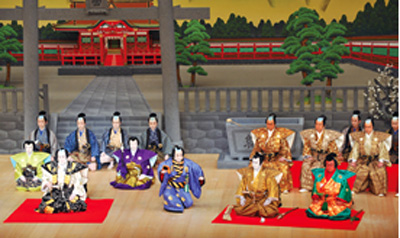About This Print
This print depicts a scene in act III from the play KajiwaraHeiza Homare no Ishikiri, in which the hero, Kajiwara Kagetoki, seated center, inspects a precious sword that has been offered for sale. The play was performed at the Mitsukoshi Theater (三越劇場 Mitsukoshi gekijō) in February 1949. The print is one of an unknown number of prints created by Sasajima for the 1948 and 1949 kabuki seasons at the Mitsukoshi Theater.Kajiwara Kagetoki, the 12th-centuryhero of this historical drama, is famed for his ambiguous political positions,as he deserted the Heike to fight for the Genji under Minamoto noYoritomo. Often treated as a traitor, inthis play he receives a positive portrayal. The play, first written for thepuppet theatre, was adapted for Osaka kabuki in the same year but was not seenin Edo until 1795. Only act 3, usuallycalled “Ishikiri Kajiwara,” is performed.
It is cherry blossom time atthe Hachima Shrine in Kamakura, where Ōba Saburō and others arecelebrating a Heike victory over Yoritome at Ishibashiyama when Kajiwara joinsthem, although tension exists between Saburō and Kajiwara. The old inlay craftsman Rokurōdayūand his daughter, Kozue, appear, hoping to sell a precious sword to raise warfunds for Yoritomo. Saburō is interested,but the high price of 300 ryō makeshim hesitate. Kajiwara, known for hisexpertise, is asked to judge the sword’s quality. Kajiwara conducts a thorough inspection anddeclares the sword outstanding, but Saburō says the true test would be to seeif it could slice through two human bodies in one blow.
Two criminals scheduled forexecution are called for; only one being available, Rokurōdayū sendsKozue off on a mission and volunteers to be the second body, the payment to goto Kozue. Kajiwara says he will have nopart of such a deal, but a messenger announces the approach of Yoritomo’s army,which convinces Kajiwara to conduct the test. The condemned man is placed over the body of Rokurōdayū, and whenKajiwara brings the blade down, it slice the criminal in half (a dummy is used)but only severs Rokurōdayū’s ropes, leaving him unscathed. Saburō now believes the sword is not sharpenough to buy, but when alone with old man Kajiwara admits he acteddeliberately so as to prevent the sword’s purchase by a Heike. He intends to switch to the Genji and, in a monogatari, recounts an experience hehad that convinced him Yoritomo was divinely protected and deserved hissupport. To allay Rokurōdayū’ssuspicions about the sword, Kajiwara easily slices a stone trough in half withit.
The Actors in the Print
Print Details
| IHL Catalog | #1379 |
| Title | Ichikawa Somegorō, et al., in Ichikiri Kajiwara at the Mitsukoshi Theater |
| Series | Mitsukoshi Kabuki Hanga 三越歌舞伎版画 [untitled series of prints for the Mitsukoshi Theater 1948 and 1949 kabuki seasons] |
| Artist | Sasajima Kihei (1906-1993) |
| Signature | not signed |
| Seal | 笹 (artist's "sasa" seal) |
| Publication Date | 1949 |
| Publisher | likely Mitsukoshi Gekijō or the artist |
| Carver | self-carved |
| Impression | excellent |
| Colors | excellent |
| Condition | good - minor handling/printing creases, mild toning, irregular margin right corer |
| Genre | sosaku hanga; kabuki-ga |
| Miscellaneous | |
| Format | |
| H x W Paper | 7 3/16 x 9 3/8 in. (18.3 x 23.8 cm) |
| H x W Image | 5 7/8 x 7 3/4 in. (14.9 x 19.79 cm) |
| Collections This Print | |
| Reference Literature |




